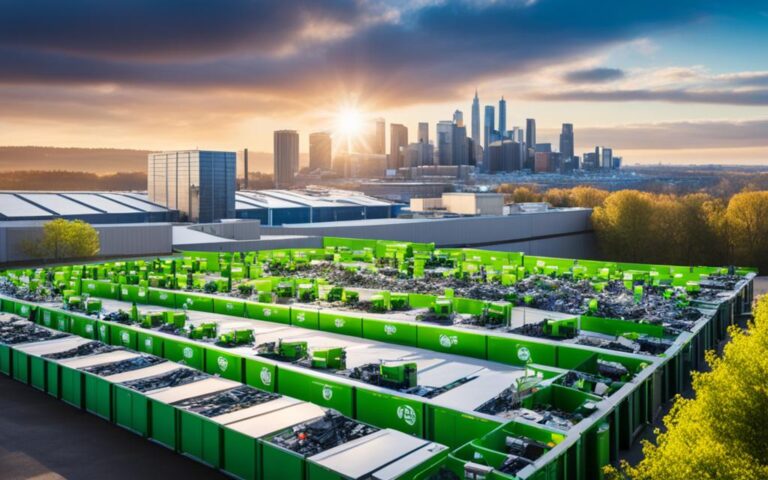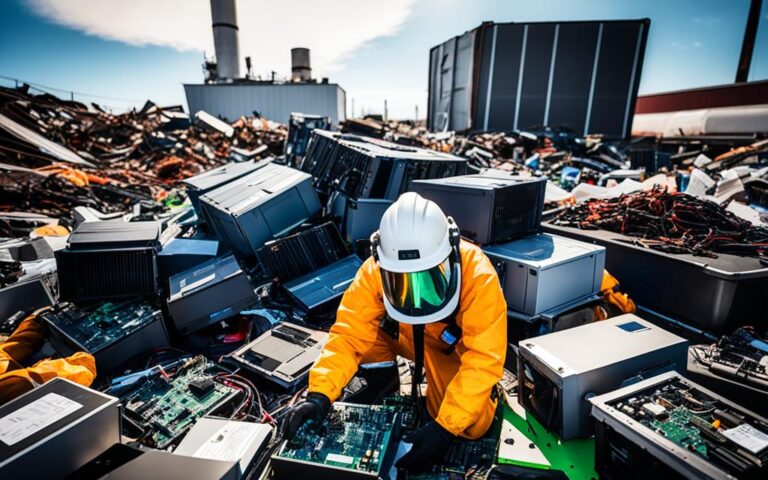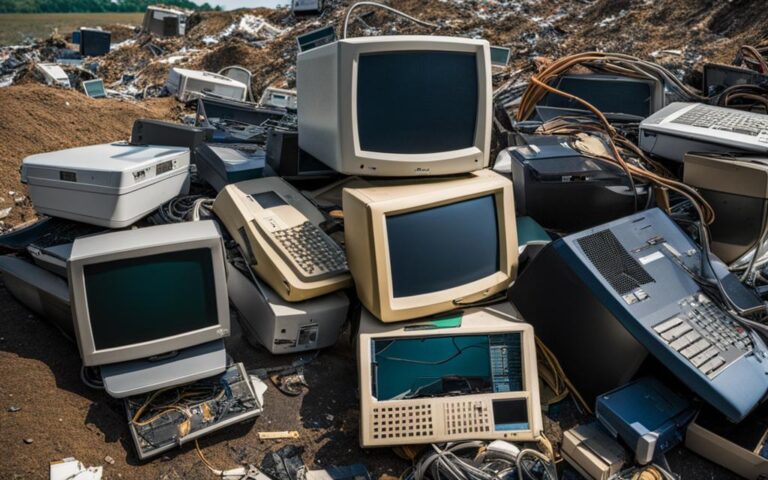The Importance of Transparency in the Server Recycling Process
In today’s digital age, server recycling plays a vital role in both data protection and environmental sustainability. Proper disposal of servers is crucial to prevent data breaches and legal non-compliance. Additionally, responsible server recycling helps reduce the negative impact of electronic waste on the environment. Transparency throughout the server recycling process is of utmost importance, as it ensures accountability and promotes sustainable practices.
The Environmental Impact of Improper Server Disposal.
Improper server disposal can have a significant and detrimental impact on the environment. Servers, which are essential components of our digital infrastructure, contain hazardous materials such as lead and mercury. When these materials are not properly disposed of, they can leach into the ground, posing serious risks to both ecosystems and human health.
The growing concern of electronic waste, or e-waste, further exacerbates the environmental impact of improper server disposal. When servers are not recycled, they contribute to the mounting problem of electronic waste. E-waste is a global challenge due to its toxic components and the sheer volume of discarded electronics.
Adopting effective server recycling methods is crucial to reduce the demand for raw resources and minimize the negative environmental imprint caused by electronic waste. Properly disposing of servers through responsible recycling processes ensures that valuable materials are recovered and reused, reducing the need for new resource extraction.
By implementing sustainable server disposal practices, we can not only prevent the release of hazardous materials but also work towards a more circular economy. Rather than treating servers as disposable items, recycling them allows for valuable resources to be conserved, reducing the strain on the environment and promoting long-term sustainability.
The Hazards of Improper Server Disposal
“Neglecting proper server disposal has severe consequences for the environment and human well-being. We must prioritize responsible recycling practices to protect our planet and preserve its natural resources.”
| Hazardous Materials in Servers | Environmental Impact |
|---|---|
| Lead | Risk of soil and water contamination |
| Mercury | Potential harm to ecosystems and human health |
| Brominated Flame Retardants (BFRs) | Persistent organic pollutants; potential for bioaccumulation in wildlife |
| Cadmium | Soil pollution; harmful effects on flora and fauna |
Image:
Understanding the Server Recycle Process.
Server recycling plays a crucial role in protecting sensitive data and minimizing the environmental impact of electronic waste. By breaking down servers into their component parts, ensuring secure data destruction, and adopting environmentally responsible practices, organizations can contribute to a more sustainable future.
When servers are recycled, they are carefully disassembled to separate the various component parts. These parts can include metals, plastics, circuit boards, and other materials. By recognizing the common materials found in servers, organizations can ensure that each component is directed towards the most appropriate and sustainable end-use.
Secure data destruction is a vital step in the server recycle process. It involves the complete eradication of any data stored on the servers to prevent unauthorized access. Specialized software or methods are used to wipe the data multiple times, ensuring its irretrievability.
“Server recycling is not just about dismantling and disposing of hardware. It’s about ensuring that no trace of sensitive data remains and finding the best possible way to reuse or recycle each component responsibly.”
Environmental responsibility is a key aspect of the server recycle process. Instead of sending servers to landfills, where they can release toxic substances into the environment, environmentally responsible recycling practices aim to reduce the negative impact of electronic waste. This approach helps preserve natural resources, minimize pollution, and support a circular economy.
By extending the lifecycle of valuable materials through component reuse or recycling, organizations can significantly reduce the demand for raw resources. This reduces the environmental burden of extracting and processing new materials, while also minimizing the carbon emissions associated with manufacturing and transportation.
The server recycle process aligns with the principles of environmental sustainability and responsible resource management. It promotes the reuse and recycling of component parts, ensuring that valuable materials are not wasted. By adopting these practices, organizations demonstrate their commitment to both data security and environmental stewardship.
The Step-by-Step Guide to Effective Server Disposal.
Proper server disposal is a crucial process that requires careful planning and execution. To ensure the secure and environmentally responsible disposal of servers, follow this step-by-step guide:
Data Backup
Before beginning the disposal process, it is essential to back up all data stored on the server. This step ensures that important information is not lost during the disposal process. Backing up the data to an external storage device or cloud-based backup system provides a safety net against accidental data loss.
Data Wiping
Once the data has been backed up, the next step is to perform a thorough data wipe to ensure complete data destruction. Data wiping involves securely removing all data from the server’s storage devices, making it unrecoverable. Specialized software or methods which overwrite data multiple times should be used to guarantee data security. This process renders the server’s data inaccessible and protects sensitive information from falling into the wrong hands.
Choosing the Right Disposal Method
After data backup and wiping, it is essential to choose the most suitable server disposal method based on the condition and security needs of the server. There are several options to consider:
- Repurposing: If the server is still functioning and meets the requirements of another department or organization, repurposing the server can extend its lifecycle and prevent unnecessary waste.
- Recycling: If the server is obsolete or cannot be repurposed, recycling is a responsible option. Certified recycling facilities can dismantle the server and recycle its component parts, ensuring that valuable materials are reused while minimizing environmental impact.
- Secure Destruction: In cases where strict data security is of utmost importance, secure destruction is the recommended method. This involves physically destroying the server to ensure that no data can be recovered.
Certified Recycling Facilities
Lastly, it is crucial to work with certified recycling facilities that follow best practices for both environmental safety and data protection. Certified recycling facilities have the necessary expertise and equipment to handle server disposal safely and responsibly. By partnering with these facilities, you can have peace of mind that the servers will be disposed of in an ethical and environmentally friendly manner.
Following this step-by-step guide will ensure that server disposal is carried out effectively, safeguarding sensitive data and reducing environmental impact.
Benefits of Proper Server Recycle Practices.
Proper server recycling practices offer numerous benefits that go beyond environmental sustainability. By implementing these practices, businesses can prolong the server lifecycle, unlock economic advantages, and reinforce their commitment to data security and environmental responsibility.
Maximizing Resource Efficiency
One of the key advantages of proper server recycling practices is the ability to prolong the server lifecycle by maximizing resource efficiency. Servers consist of valuable components, such as CPUs, RAM, and hard drives, that can be reused or repurposed in other systems. By carefully disassembling and evaluating each component, businesses can identify which ones are still functional and can be utilized effectively. This approach not only reduces waste but also optimizes resource utilization, contributing to a more sustainable and cost-effective IT infrastructure.
Unlocking Economic Advantages
Recycling servers can also unlock economic advantages for businesses. Valuable components or metals recovered from recycled servers can be resold, generating additional revenue for the organization. This creates a circular economy model where waste is transformed into valuable resources, benefiting both the business and the environment. Additionally, proper server recycling practices help reduce waste disposal costs associated with e-waste, further contributing to cost savings.
Data Security and Environmental Responsibility
Proper server recycle practices play a vital role in safeguarding sensitive data and enhancing a company’s reputation for both data security and environmental responsibility. When recycling servers, it’s critical to ensure secure data destruction to prevent any potential data breaches. By leveraging specialized data wiping techniques and partnering with certified recycling facilities, businesses can effectively destroy data and minimize the risk of unauthorized access. This not only protects the business and its clients from potential legal and financial consequences but also demonstrates a commitment to data security and privacy.
In addition to data security, proper server recycling practices contribute to overall environmental responsibility. By reducing e-waste through recycling, businesses help minimize the negative impact of electronic waste on the environment. This, in turn, fosters a cleaner and more sustainable future. Adopting these practices aligns businesses with global sustainable development goals and showcases their commitment to environmental stewardship.
Summary of Benefits
The benefits of proper server recycle practices can be summarized as follows:
| Benefits | Description |
|---|---|
| Maximizing Resource Efficiency | By reusing and repurposing valuable server components, businesses prolong the server lifecycle and optimize resource utilization. |
| Unlocking Economic Advantages | Selling recovered valuable components or metals generates additional revenue, while reducing waste disposal costs. |
| Data Security and Environmental Responsibility | Proper server recycling practices ensure secure data destruction, protecting sensitive information and demonstrating commitment to data security and environmental responsibility. |
Mistakes to Avoid in Server Disposal.
When it comes to server disposal, there are several mistakes that organizations should avoid. Failing to handle the process correctly can lead to data breaches, environmental damage, and legal repercussions. By being aware of these common mistakes and taking the necessary precautions, businesses can ensure a secure and responsible server disposal process.
Improper Data Deletion
One critical mistake to avoid is improper data deletion. Simply deleting files or formatting a server is not enough to guarantee the complete removal of data. Surface-level deletion leaves traces of sensitive information that can be recovered and exploited by unauthorized individuals.
Furthermore, overlooking encrypted data can also pose a significant risk. Encrypted data must be properly decrypted and securely destroyed to prevent any potential breaches. Employing specialized data wiping tools or services can help ensure that data is thoroughly and irreversibly erased.
Illegal Dumping
Another mistake to avoid is illegal dumping of servers in landfills. This practice not only contributes to environmental damage but can also lead to legal consequences. Servers contain hazardous materials that can contaminate soil and water if not disposed of properly.
In many regions, there are regulations in place to govern the disposal of electronic waste, including servers. It is crucial for businesses to be aware of and comply with these local regulations to avoid any legal penalties. Working with certified recycling facilities that follow environmentally sustainable practices is essential for responsible server disposal.
Ensuring Proper Server Disposal
To ensure proper server disposal, businesses should follow these guidelines:
- Develop a comprehensive plan for server disposal that includes proper data deletion and recycling methods.
- Conduct a thorough inventory of servers, identifying any sensitive data that needs to be securely destroyed.
- Choose a certified recycling facility that adheres to environmentally responsible practices.
- Educate employees about the importance of proper server disposal and the potential consequences of improper handling.
- Regularly audit and review server disposal processes to ensure ongoing compliance and improvement.
By avoiding these common mistakes and following best practices for server disposal, businesses can protect sensitive data, prevent environmental harm, and uphold legal responsibilities. A responsible approach to server disposal not only safeguards valuable information but also contributes to a more sustainable and secure digital environment.
The Future of Server Recycle and Sustainability.
As technology continues to evolve, the future of server recycling is poised for significant advancements in sustainable practices and technological innovations. With the increasing rate of hardware cycling, the importance of responsible server recycling will continue to grow.
In the coming years, we can expect to see exciting developments in recycling processes and technologies. These innovations will further enhance the efficiency and effectiveness of server recycling, ensuring that valuable resources are conserved and environmental impact is minimized.
Embracing sustainable practices will be crucial for organizations to stay ahead in the server recycling landscape. By incorporating renewable energy sources and sustainable materials in server manufacturing, companies can reduce their carbon footprint and contribute to a greener future.
Furthermore, keeping abreast of industry standards and regulations will be vital in ensuring an environmentally responsible and secure server recycle future. By staying updated, organizations can navigate the evolving landscape of data privacy and security while ensuring compliance with emerging sustainability frameworks.
FAQ
Why is transparency important in the server recycling process?
Transparency in the server recycling process ensures accountability and promotes sustainable practices. It helps organizations and individuals understand how their servers are being disposed of, protecting sensitive data and reducing the negative impact of electronic waste on the environment.
What are the environmental consequences of improper server disposal?
Improper server disposal can have detrimental effects on the environment. Servers contain hazardous materials like lead and mercury that can leach into the ground, posing risks to ecosystems and human health. When servers are not recycled, they contribute to the growing problem of electronic waste, which has significant negative environmental impacts.
What does the server recycle process involve?
The server recycle process involves the breakdown of servers into their component parts, secure data destruction, and environmentally responsible reuse or recycling of the components. It aims to protect sensitive data, reduce the environmental impact of e-waste, and extend the lifecycle of valuable materials.
What steps are necessary for effective server disposal?
Effective server disposal requires preliminary steps like data backup to ensure important information is retained. Data wiping is essential for secure data destruction, using specialized software or methods that overwrite data multiple times. Choosing the right server disposal method, such as repurposing, recycling, or secure destruction, depends on the condition and security needs of the server.
What are the benefits of proper server recycle practices?
Proper server recycle practices prolong the server lifecycle by ensuring resource efficiency and maximizing the utilization of valuable components. They can also lead to economic advantages, as valuable components or metals can be resold, generating additional revenue. Furthermore, server recycle practices reduce e-waste and associated waste disposal costs, while safeguarding sensitive data and enhancing a company’s reputation for data security and environmental responsibility.
What mistakes should be avoided in server disposal?
It’s important to avoid improper data deletion methods, such as surface-level deletion or overlooking encrypted data, as they can result in data breaches and unauthorized access. Additionally, illegal dumping of servers in landfills is both environmentally damaging and potentially illegal. It’s crucial to be aware of local regulations and work with certified recycling facilities to ensure proper server disposal.
What does the future hold for server recycle and sustainability?
As technology continues to evolve, the future of server recycling lies in sustainable practices and technological advancements. With the increasing rate of hardware cycling, the importance of responsible server recycling will only grow. Innovations in recycling processes and technologies will further improve the efficiency and effectiveness of server recycling. Embracing sustainable practices and staying updated with industry standards will be key to ensuring a more environmentally responsible and secure server recycle future.















